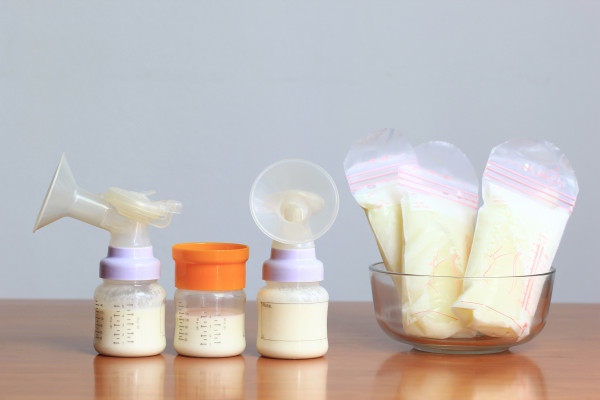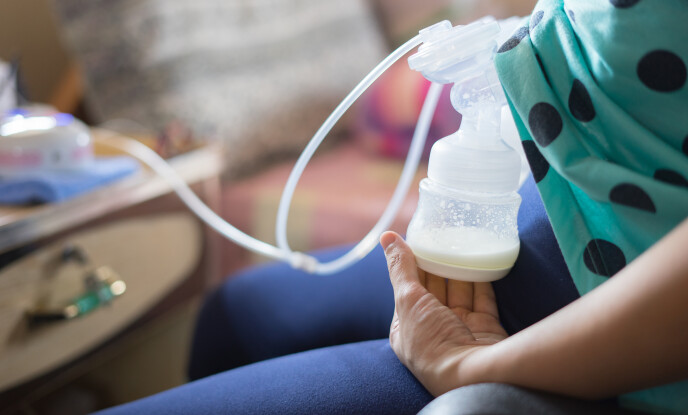Whether you’re returning to work and want to continue breastfeeding, your partner or other whānau would like to be more involved in feeding your little one, or you want to treat yourself to a long overdue rest or night out, expressing breastmilk gives you a bit of flexibility.
The best time to express milk is after a feed, and many women find the easiest time is to pump in the morning. If you express milk just before a feed, there may be less for the baby.
The amount you can express might vary during the day, and it’s different for each mother.
Pumping works best when you are relaxed. Watching the bottle fill or forcing yourself to pump when you don't want to often produces less milk. Try pumping while watching your favourite show, listening to relaxing music or cooing and singing with your baby.
Remember, your baby is best at extracting your milk so don't feel disheartened if the volumes are less than you expect. Everyone responds differently to the pump.
You might find it easier to express breastmilk if you’re in a in a comfortable, private place. Get comfortable, relax, and have a glass of water handy to drink. Allow yourself lots of time too – especially when you’re first learning to express.
Expressing breastmilk by hand
Expressing milk by hand takes a bit of practice, and it can take a while to do. If you've hand-expressed your colostrum you have a bit of a head start! Ask your Plunket nurse - or a friend who’s done it herself - for help if you need it.
- Wash your hands with soap.
- Put a clean bowl or dish under your breast to catch the milk, in a place that allows you to have both your hands free, eg between your legs, or on a low table. It's a good idea to have a clean towel nearby to catch any spills or wipe wet fingers.
- Gently massage your breast. Start from the top of your breast and stroke down towards your nipple. Move around the whole breast doing this. Do this several times so the entire breast is massaged. This helps improve your let-down reflex (the release of milk from your breast, which is triggered by a hormone called oxytocin). Use one hand to support your breast if it feels heavy.
- Position your thumb and finger opposite each other on either side of your breast, well back from your nipple.
- Gently press inwards towards your ribs, until you feel the bulk of the breast.
- Gently press your finger and thumb towards each other using a rhythmic rolling movement. This will compress the milk ducts inside your breast, and milk will flow out of your nipple.
- You may only get a few drops at first, but once your let-down reflex happens, you should get sprays from the nipple with each squeeze.
- Once the milk flow slows, move your fingers to a new position around the nipple and do the same again. Move around your nipple until you've emptied all sectors of the breast, changing hands if your fingers get tired.
- Take a break before you repeat the process on the other breast.
- If you need more milk, change from breast to breast, or wait and try again later.
- Store what you’ve already pumped into a bottle or bag and refrigerate it. If you try again later the same day and get more milk, wait for the new milk to cool (or refrigerate it for 30-60 minutes). Once it’s cool, you can add it to the other container of refrigerated milk.
Expressing breastmilk with a hand-held pump
Hand-held breast pumps normally have a suction cup attached to a pump handle and a bottle or container.
- Get yourself relaxed and comfortable.
- Gently massage your breast. Start from the top of your breast and stroke down towards your nipple. Move around the whole breast doing this. Do this several times so the whole breast is massaged. This helps improve your let-down reflex.
- Put the suction cup of the pump directly over your breast with your nipple in the centre.
- Squeeze the pump handle gently and rhythmically – you might see only drops of milk until your let-down happens, and then it’ll spray.
- Pump until your milk flow stops.
- Store what you’ve already pumped into a bottle or bag and refrigerate it. If you try again later the same day and get more milk, wait for the new milk to cool (or refrigerate it for 30-60 minutes). Once it’s cool, you can add it to the other container of refrigerated milk.

Expressing breastmilk with an electric pump
Electric breast pumps are pretty much the same as hand-held pumps, but you don’t have to do the pumping yourself.
- Get yourself relaxed and comfortable.
- Gently massage your breast. Start from the top of your breast and stroke down towards your nipple. Move around the whole breast doing this. Do this several times so the whole breast is massaged. This helps improve your let-down reflex.
- Put the suction cup of the pump directly over your breast (or breasts, in the case of double pumps) with your nipple(s) in the centre.
- Start with low suction and increase it to a level that’s comfortable for you.
- Pump until your milk flow stops.
- Store what you’ve already pumped into a bottle or bag and refrigerate it. If you try again later the same day and get more milk, wait for the new milk to cool (or refrigerate it for 30-60 minutes). Once it’s cool, you can add it to the other container of fresh refrigerated milk.
You can buy or hire electric breast pumps. Some stores and pharmacies hire them out, but you’ll need to buy your own pump kit to attach to the electric pump.
In some places around New Zealand, District Health Boards loan breast pumps for babies in special care, and some offer a hire service for hospital-grade breast pumps.
If you’re eligible, you may be able to access Work & Income support to buy or hire a breast pump. Look under "help with costs for the baby" on the linked page.
How to store expressed milk
It is best to express directly into a sterilised plastic container, or you can store your breastmilk in a clean, closed container or a special breastmilk storage bag.
It’s a good idea to store the milk in small amounts. Covered ice cube trays are good because they’re easily thawed. Make sure you label it with the date it was expressed, and label it as expressed milk so it’s not mistaken for anything else!
Milk storage guidelines
|
Storage conditions |
Storage time |
Comments |
|
Room temperature (< 26ºC) |
4 hours |
Cover containers and keep them as cool as possible (for example, you could surround the closed container with a cool towel to help to keep the milk cooler).
|
|
Refrigerated (2–4˚C) |
72 hours (three days) |
Store milk in the lower half, at the back of the refrigerator.
|
|
Frozen • Freezer box in refrigerator • Separate door fridge/freezer • Separate deep freeze |
2 weeks 3-6 months 6-12 months |
Store milk toward the back of the freezer, where the temperature is most constant. |
From Ministry of Health Food and Nutrition Guidelines for Healthy Infants and Toddlers (PDF) – a background paper
Don’t add fresh, warm expressed milk to milk that’s already frozen or cold.
Previously frozen breastmilk (thawed in the fridge but not warmed)
You can store breastmilk:
- at room temperature (26ºC or lower) for four hours or less – that is, until the next feed
- in the fridge for up to 24 hours – the best spot is the back of the fridge where it’s coldest.
Breastmilk thawed outside the fridge in warm water
You can store breastmilk:
- at room temperature (26ºC or lower) until the end of the feed
- in the fridge for four hours or until the next feed.
Don’t refreeze previously frozen breastmilk.
How to thaw frozen breastmilk
- Allow your frozen breast milk to defrost itself in the fridge. When it’s thawed, use it straight away.
- Hold the container under cold running water, then gradually warmer water to bring the milk to body temperature.
- Breast milk isn’t homogenised (ie. the fats aren’t mixed in with the milk) so it will separate. Swirl gently to mix.
If your baby doesn’t finish their feed of expressed breastmilk, you can’t use it for another feed - just throw it away.
Warming expressed breastmilk
The safest way to warm breastmilk is to stand the container in warm water. If you have fresh breastmilk, use that first. If you're using frozen breastmilk, you can thaw it by putting the container in either cool or warm water.
After warming, gently swirl the bottle, and test the temperature to make sure it's lukewarm or around body temperature before you feed it to your baby.
Microwaving bottles is not recommended because the uneven heating of the milk can burn your baby’s mouth, and the heat can also damage the health-protecting qualities of breast milk.
Using expressed breastmilk when you’re out and about
You can move expressed breastmilk between home and other places – for example, to work to feed your baby during the day.
Expressed breastmilk can travel:
- in an insulated container like a chilly bin or cooler bag with a freezer pack
- either frozen or fresh – if the milk has thawed, use it within four hours and don’t refreeze it.
Place the labelled breastmilk in the fridge as soon as you arrive or in the freezer if it’s still frozen.
Cleaning expressing equipment
It’s important to clean and sterilise the pump, teats, and bottles or cups.
If you’re using a breast pump:
- clean it with washing-up detergent, water and a brush
- sterilise the breast pump, the bottle/cup and storage container by boiling them for five minutes (boil teats for three minutes) or
- use a sterilising solution.
If you’re bottle-feeding:
- clean the teat and the bottle with washing-up detergent and water
- make sure you get all the milk out.
Once your baby is over six months old, you don’t need to sterilise the equipment; just clean it thoroughly with hot soapy water and rinse well.
